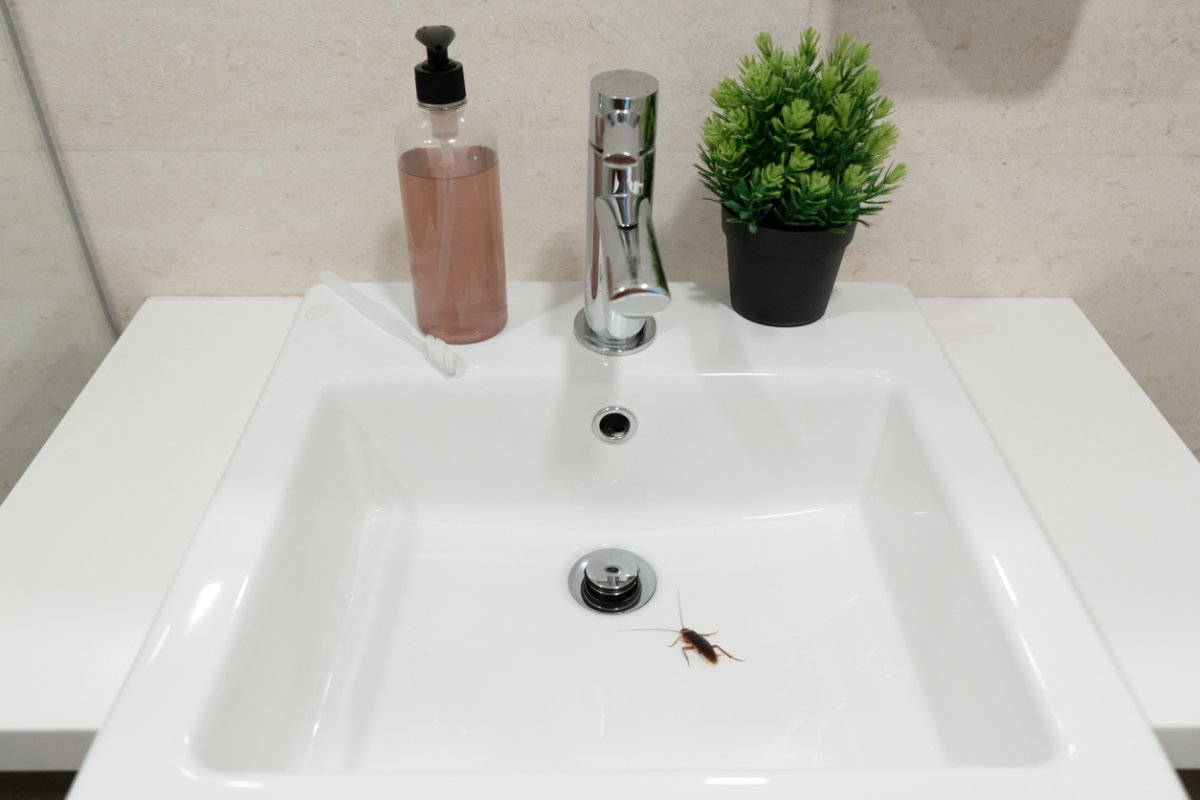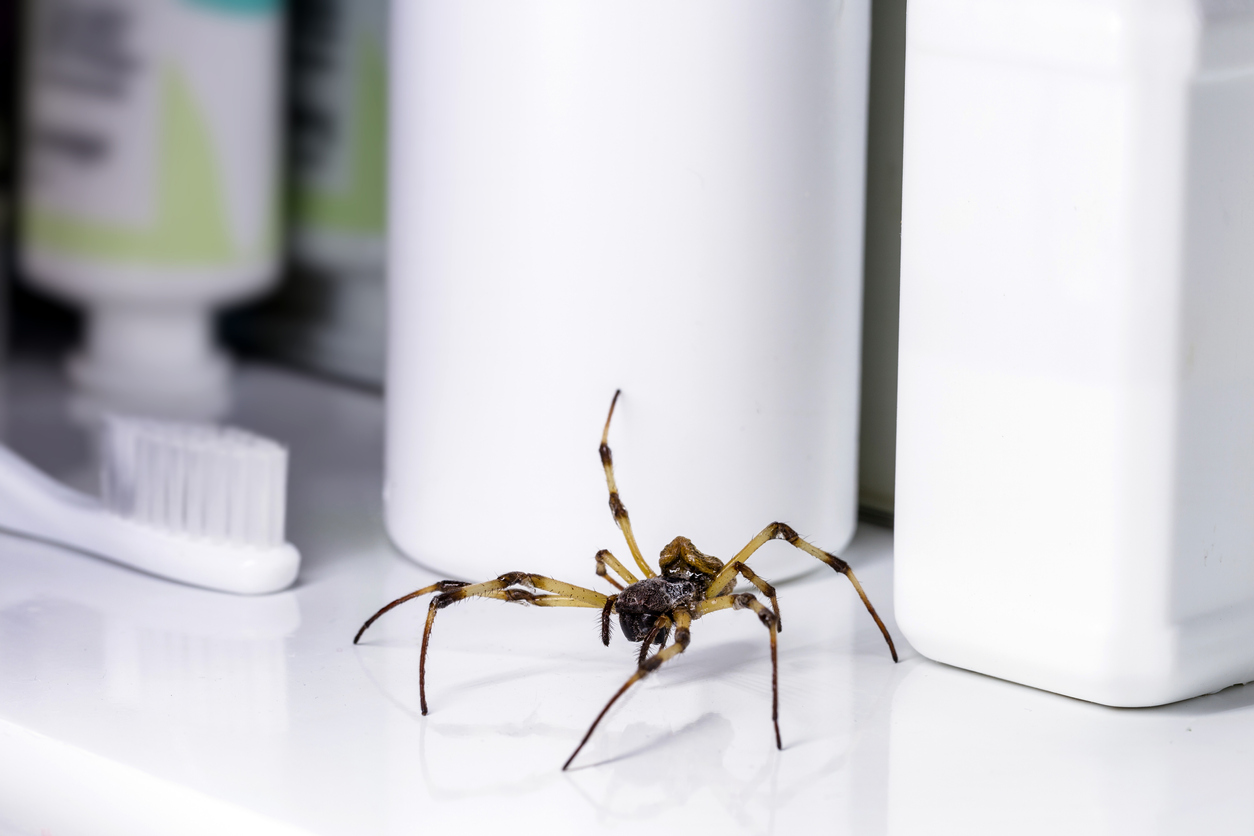

We may earn revenue from the products available on this page and participate in affiliate programs. Learn More ›
What You Need to Know
- There are several potential culprits that could be the tiny black bugs in the bathroom.
- Common bathroom bugs include drain flies, cockroaches, silverfish, mold mites, fungus beetles, centipedes, and spiders.
- Some potential solutions include cleaning the drains, decreasing moisture levels, and addressing mold swiftly.
- A pest control company can help rid the bathroom of tiny black bugs if the infestation is too widespread to DIY.
Q: For a while, I have been finding tiny black bugs in my bathroom sink. They don’t look like houseflies, gnats, or any other bug I have seen. What are these tiny black bugs in my bathroom, and how do I get rid of them?
A: Lots of critters are drawn to warm and humid conditions, so the identification of bathroom bugs is not always straightforward. One way to differentiate these pests is to consider where they are located—for example, bugs in the toilet are likely different from small black bugs in the house near the window. The tiny black bugs in the bathroom sink you’re seeing could be coming from the drain. If so, the likeliest culprit is drain flies, but they could also be baby cockroaches. Read on to learn more about tiny black bugs in bathrooms, what attracts them, and how to get rid of them for good.
Dirty or clogged drains can attract drain flies.
Drain flies, sometimes incorrectly called drain mites or bathroom mites, are one of the most common tiny black bugs in bathrooms because they thrive in warm, damp conditions. These insects are small black bugs with hairy bodies and antennae. While they have wings, they don’t fly as well as regular houseflies and may appear to hop instead.
Drain flies lay their eggs in the built-up sludge of sink and shower drains, but homeowners may also see these bugs coming out of drains or jumping along their bathroom floor. Thankfully, drain flies will only infest a dirty or clogged drain, so getting rid of drain flies can be as simple as cleaning the drain. To do this, first use a drain snake or pipe brush to loosen as much gunk from the drain as possible and break up any clogs. Then, flush it out with a drain cleaner. Because bugs in drains rely on the decomposing matter to eat and reproduce, once the drain is completely cleared, they will be forced to find another home.

Drains that are always getting clogged can benefit from a professional drain cleaning.
The average homeowner can usually make quick work of an occasional shower or sink clog. However, drains that clog constantly may have significant grease buildup, or the clog may be too deep to be reached with a drain snake. These stubborn cases may need to be handled by one of the best drain cleaning services. After all, clogs are an annoying inconvenience and can lead to water contamination, unpleasant smells, pests, or burst pipes if they go unaddressed for too long. A professional plumber can quickly identify and remove the clog before it leads to a whole host of other, more severe issues.
Other bugs are attracted by the moisture in bathrooms.
All bathrooms can be prone to dampness, but excessive humidity is one of the most common things that attract pests in a home. Damp environments are a boon not only to drain flies, but also to cockroaches, silverfish, and more. One solution is ensuring adequate ventilation in the bathroom by running the exhaust fan after showering and leaving the door open throughout the day. It’s also a good idea to repair any leaks or dripping faucets. Lastly, warmer weather also tends to lead to damper conditions, so insect activity in homes typically peaks in the summer.

- Cockroaches: Roaches, also called waterbugs, are one of the most common bathroom bugs. Cockroaches are small brown bugs that are attracted to damp, warm bathrooms. They can often enter from other parts of the home through connected drains and ductwork. Cockroaches will eat any organic matter, including paper and trash, so keeping the bathroom dry and clear of clutter will help get rid of waterbugs.
- Silverfish: While silverfish are often found near drains, they do not live in them like drain flies do. These scaly, fast-moving insects eat starchy materials and are especially attracted to mold. Silverfish lay eggs in cracks and small crevices, so filling gaps with caulk and eliminating excess mold and mildew should discourage silverfish from living in a bathroom.
Mold and mildew can invite certain bugs.
In addition to attracting insects, damp conditions also provide a breeding ground for mold and mildew. This is a cyclical issue because mold, in turn, is a food source for bugs such as mold mites and fungus beetles. So what kills mold? Vinegar is an effective home remedy, and so is hydrogen peroxide or a solution of water and baking soda. The best way to keep the bathroom both mold- and bug-free is to deal with the humidity problem. For an advanced mold issue, it’s a good idea to consider hiring one of the best mold removal companies.
- Mold mites: Mold mites are tiny arthropods that develop on mold patches. Mold mites have soft, furry white bodies but cannot be seen without a microscope. Instead, they may leave behind brown “mite dust,” which can be seen under a bright light. The best way to eliminate mold mites is to get rid of the mold, their food source.
- Fungus beetles: The term “fungus beetle” can refer to several insect species that feed on mold. Fungus beetles are just as likely to be found in the pantry as in the bathroom as long as conditions are right: damp with access to mold and mildew. As with mold mites, remedying mold and humidity often makes fungus beetles disappear.
Predator bugs can make their way into a bathroom by following their prey.
Some bugs, like centipedes and spiders, are also commonly found in bathrooms, but not because they like dampness and mold. Instead, these conditions have attracted prey that these bugs eat. So, unfortunately, spotting a spider in the bathroom might signal a larger problem. On the other hand, once the small bugs in the bathroom are eliminated, the centipede or spider problem will likely take care of itself.

- Centipedes: House centipedes are generally considered to be one of the more unpleasant bugs to find in a bathroom. However, some homeowners don’t mind these mostly nocturnal bugs because they eat flies, silverfish, cockroaches, and other common household insects. However, once the centipedes lay eggs, it may be difficult to get rid of them.
- Spiders: There are many different types of spiders found in homes in North America, and some are more dangerous than others. Most are relatively harmless to humans but prey on insects like flies and mosquitoes. Spiders enter the home through gaps in doors and windows or even plumbing lines, so sealing these areas can help keep them out.
Tiny black bugs in the bathroom are usually harmless.
While homeowners would generally prefer not to find drain flies and other tiny bugs in the bathroom, the good news is that most are just unpleasant, not dangerous. That said, there are plenty of ways to make a bathroom less hospitable to these uninvited guests. One is keeping drains clean and unclogged. This will discourage drain flies and cockroaches from hiding out in plumbing and appearing in the sink or bathtub. A plumber or drain cleaning service can ensure that drains are free of blockages and that they stay that way. This can also help with getting rid of gnats or small flies in bathrooms since they also like to hang out around smelly drains. Dehumidifying the bathroom by repairing leaks and ensuring proper ventilation will also discourage pests and mold. If there are still bugs in the bathroom after these measures have been taken, consider hiring one of the best pest control companies like Orkin or Terminix to eliminate them for good.
